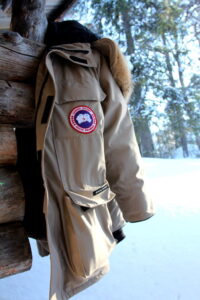by The Cowl Editor on November 21, 2019
Opinion

by Joseph Kulesza ’22
Opinion Staff
As winter approaches, a mirage of coats, jackets, and sweaters will begin to appear on students around the Providence College campus. While many might be branded with the words “Patagonia” or “L.L. Bean”, the most controversial of these clothing articles has a large red circle embroidered on the sleeve, and has been featured in more than just commercials promoting the sale of this product.
With humble beginnings as a working class jacket, it is surprising to see just how far the Canada Goose jacket has come. From the backs of working class laborers in the oil fields of Northern Canada, to Kate Upton’s in a Sports Illustrated Swim Suit Edition that brought unprecedented recognition to this brand, Canada Goose is the antithesis of the saying that “success doesn’t happen overnight”.
From the years 2015 to 2018, the company experienced a 77% increase in revenues, and as its revenues increased, so did the likelihood of seeing this jacket being worn by figures other than super models and Canadian oil field workers.
Canada Goose’s overnight success has been accompanied by controversial news stories, smear campaigns from PETA, and instances of this jacket even being banned from certain school districts in the United Kingdom.
With all of this controversy surrounding the brand, the question arises as to whether any of it is justified, as a winter outerwear company usually is not the first idea that comes to mind when thinking of controversial matters. This is especially apparent in the context of a tumultuous year, including ongoing Middle Eastern civil wars, government impeachment hearings, and international trade tariffs.
The outrage associated with Canada Goose stems from multiple origins, but for the sake of brevity, this article will only focus on the controversy regarding the social implications of this jacket.
Most of Canada Goose’s success has come through the company’s ability to occupy a specific niche within the discretionary market.
Nestled in-between more common manufacturers such as Patagonia, and ultra high-end luxury brands such as Moncler, Canada Goose is just expensive enough to boast a degree of exclusivity, yet is not so expensive that it is affordable to only an elite portion of the population.
This positioning of Canada Goose results in a divide between the people who have Canada Goose and those who do not that is prevalent enough to be seen as an issue, and is claimed to exacerbate socioeconomic differences between students.
Although this philosophy is not commonly-followed in our materialistic society, consumers should buy discretionary goods like they buy stocks—purchase items for their intrinsic value rather than value that is perceived.
This notion seems rather arbitrary, but becomes pertinent after realizing that the market price of a product reflects both its actual worth and value that consumers think the product is worth.
In the same way that speculation drives up stock prices, the speculated value of products—existent mainly in the social capital a product possesses— artificially inflates a product’s demand, allowing producers to charge prices that are disproportional to the cost of comparable alternatives.
The only real difference between a $1,195 Canada Goose parka and a $400 Arc’ teryx one (which uses a higher quality down than Canada Goose), is a circular logo on the arm of the more expensive one. Contained in this logo is the social capital associated with the product, and along with this idea comes the price that is unattainable for many.
Purchasing products like we do stocks is a way to protect consumers from inflated prices, all the while giving us the peace of mind that there is one less-controversial topic for your relatives to get into an argument about at Thanksgiving dinner.